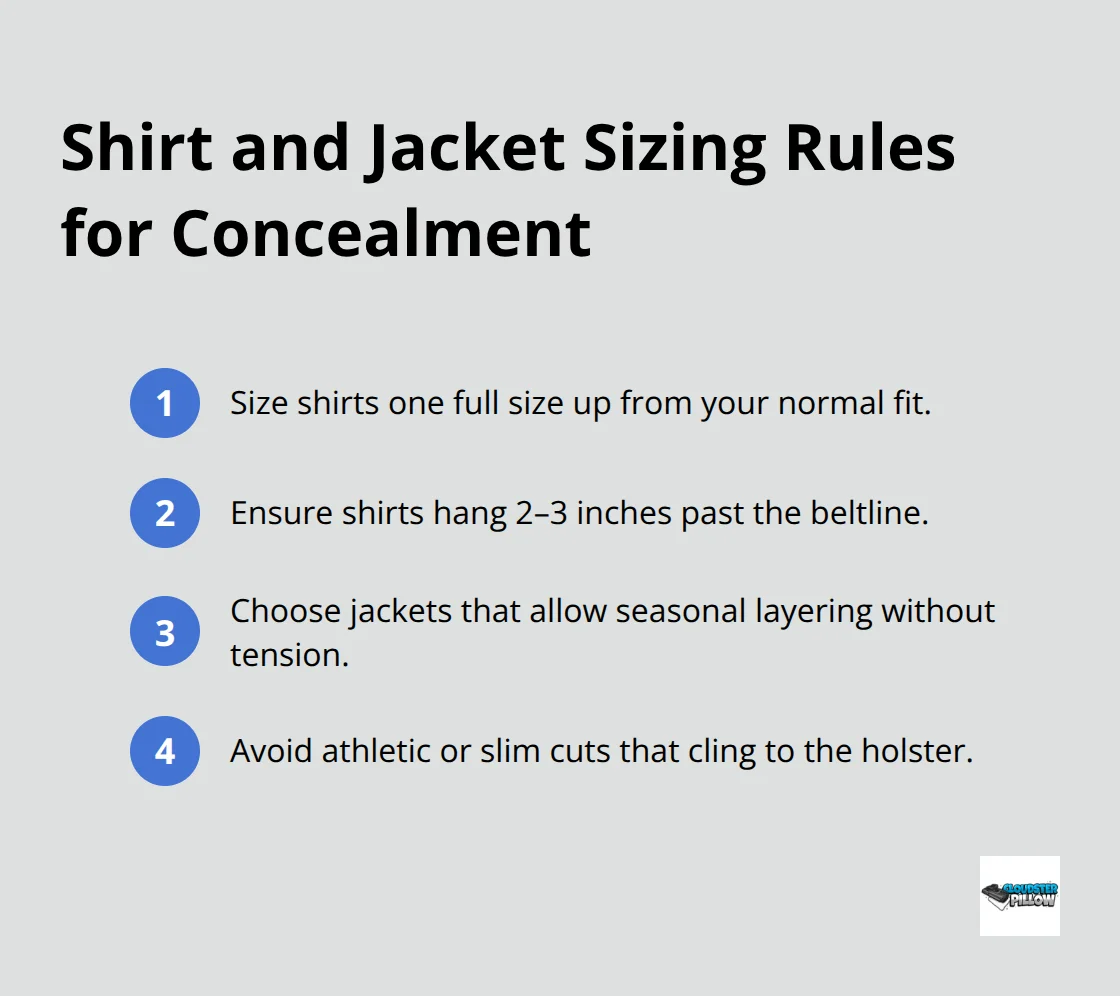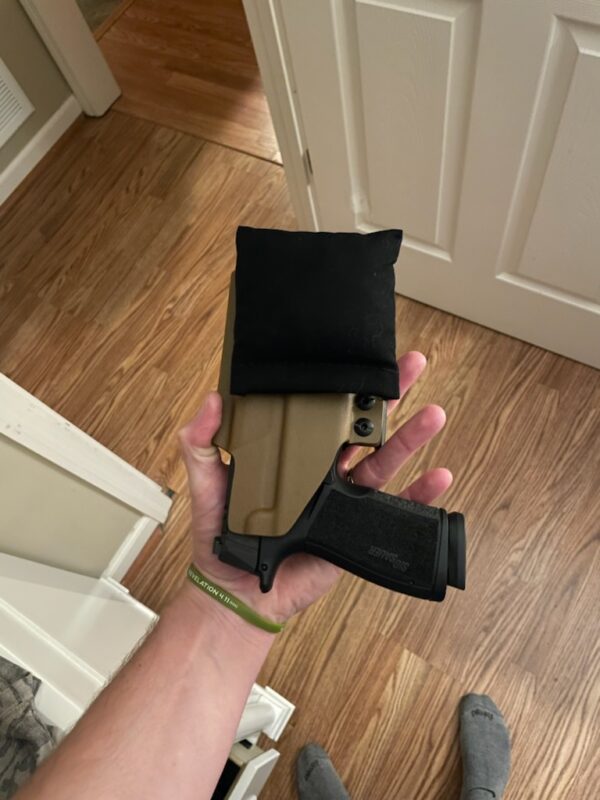IWB Holster Wedge
How to Stop Printing When Carrying Concealed [Guide]
CCW printing happens when your concealed firearm becomes visible through your clothing, creating an outline or bulge that reveals you’re carrying. This common issue affects both new and experienced carriers.
We at Cloudster Pillow understand that proper concealment requires the right combination of clothing choices, holster positioning, and body awareness. Master these fundamentals to carry confidently without compromising your concealment.
Why Does Printing Happen
Printing occurs when your firearm creates a visible outline through fabric. Tight clothing, improper holster position, or specific body movements cause this visibility issue. The most common culprit involves clothing that clings to your body shape.
The Physics Behind Visible Outlines
Cotton t-shirts and fitted garments wrap around your holster and firearm, which creates telltale bulges. These materials lack the structure to maintain their shape over irregular objects. Loose fabric around your waistline moves independently from your body, making print visibility less likely. Synthetic blends with more body often perform better than thin cotton materials.

How to Spot the Warning Signs
Your firearm prints when others can see distinct geometric shapes through your clothing that don’t match natural body contours. Sharp rectangular outlines at your waistline signal obvious visibility issues. The grip of your pistol often creates the most noticeable bulge, especially when you bend forward or reach overhead.
Watch for fabric tension lines that radiate from your holster area. Check yourself in mirrors throughout the day, particularly after extended periods of sitting. Your clothing shifts position during normal activities (sitting, driving, or walking), and what concealed perfectly while standing may print visibly after you stand up from a chair.
Legal Consequences You Face
Virginia law treats visible firearms as open carry, which requires different legal considerations than concealed carry. Accidental visibility can void your concealed carry status in that moment. Some states impose penalties for inadequate concealment, though enforcement varies significantly.
More importantly, visible outlines alert everyone around you to your armed status. This creates tactical disadvantages and unwanted attention from both criminals and law enforcement. Store employees may ask you to leave private property, and nervous citizens often call police when they spot obvious signs. Professional consequences can include workplace discipline or termination (regardless of your permit status).
The right clothing choices and holster setup eliminate these risks entirely while maintaining your comfortable concealed carry throughout the day.
What Clothing Actually Prevents Printing
Your fabric choice determines success or failure in concealed carry. Polyester blends maintain their shape over irregular objects while cotton clings to every contour of your holster. Structured fabrics like canvas or duck cloth create natural drape that breaks up firearm outlines. Avoid thin materials as they telegraph every detail of your setup.
Proper Shirt and Jacket Sizes
Purchase shirts one full size larger than your normal fit for effective concealment. A medium carrier needs large shirts to accommodate holster bulk without fabric tension. Your shirt should hang 2-3 inches past your beltline to cover holster clips and prevent exposure during movement. Jacket sizes follow the same principle but allow for seasonal layers underneath.

Athletic cuts and slim fits work against concealment regardless of fabric quality.
Pattern Selection That Works
Solid colors highlight every bump and irregularity your holster creates. Busy patterns like plaids, florals, or geometric designs break up visual lines and disguise printing effectively. Vertical stripes work better than horizontal ones (they draw the eye up and down rather than across your waistline). Dark colors conceal better than light ones, but medium tones with patterns provide the best combination of concealment and versatility.
Strategic Layers Without Bulk
Winter concealment benefits from base layers that wick moisture while outer shells provide structure. Merino wool base layers regulate temperature without adding bulk that competes with your holster for space. Flannel shirts over t-shirts create visual texture that disrupts print patterns. Spring and fall demand lightweight cardigans or unbuttoned overshirts that move independently from your torso.
Summer carriers face the biggest challenge but lightweight linen blends or structured cotton button-ups breathe while maintaining enough body to conceal effectively. These fabric choices set the foundation, but your holster position and body mechanics complete the concealment equation.
Where Should You Position Your Holster
Your body type determines the optimal carry position more than personal preference. Athletic builds with narrow waists excel with appendix inside-the-waistband carry at the 1 o’clock position, where the holster sits naturally against flat abdominal muscles. Average builds benefit from strong-side hip carry at 3 o’clock, which distributes weight evenly while maintaining quick access. Larger frames achieve better concealment with behind-the-hip carry at 4-5 o’clock, where natural body curves help break up firearm outlines.
Fine-Tune Cant and Ride Height
The FBI recommends a 10-15 degree forward cant for most carriers, which positions your grip at the optimal draw angle while reducing print visibility. Set your holster ride height so the grip sits just below your beltline when you wear properly fitted clothes. Taller individuals need higher ride positions to prevent grip exposure, while shorter carriers benefit from lower positions that maximize concealment under standard shirt lengths. Adjust these settings in quarter-inch increments until your firearm disappears completely under your normal clothes.
Move Without Exposure
Master the tactical squat instead of bending at the waist when you pick up objects. This technique keeps your torso upright and prevents your shirt from riding up over your holster. When you reach overhead, use your non-dominant hand while you keep your strong side pressed against your body. Sit down by backing into chairs rather than approaching from the front (this prevents your holster from shifting forward and creating visible bulges).

Practice these movements at home until they become automatic responses that maintain concealment during everyday activities.
Test Different Positions
Start with the 3 o’clock position for your first week of carry, then experiment with appendix carry if your body type allows it. Some carriers find success with the 4:30 position, which splits the difference between hip and back carry. Test each position during normal daily activities like driving, sitting at a desk, and walking up stairs. Your optimal position balances comfort, concealment, and draw speed (not just one factor alone).
Final Thoughts
CCW printing stops when you master three core elements: proper clothing selection, optimal holster position, and consistent movement awareness. Structured fabrics in larger sizes create natural drape that hides firearm outlines. You position your holster based on your body type rather than preference, then fine-tune cant and ride height through systematic testing.
Daily practice with your concealment setup builds confidence over time. You practice tactical movements like squats instead of bends, and check your concealment in mirrors throughout the day. Your muscle memory develops over weeks of consistent carry (this makes proper concealment automatic rather than conscious effort).
You maintain situational awareness without paranoia about your concealment status. Focus on your surroundings and potential threats rather than constantly check if your firearm shows. We at Cloudster Pillow understand that comfort enhances concealment effectiveness, which is why our holster wedge collection helps carriers achieve all-day comfort and confidence with their existing holster systems.

